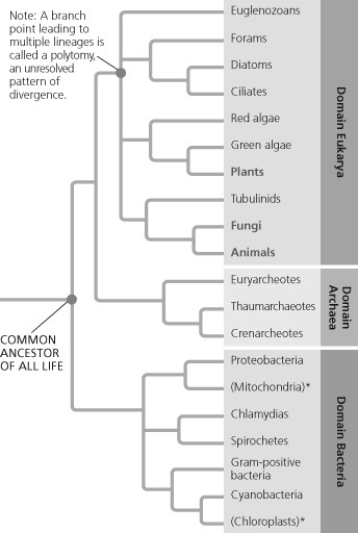
A phylogenetic tree is shown for the three domains of life (Eukarya, Archaea, and Bacteria) . The tree branches in two directions from the first point, labeled Common ancestor of all life. One branch leads in the direction of Eukarya and Archaea, and the other branch leads to Bacteria. The branch leading to Eukarya and Archaea divide, one branch leading to each domain. The branch leading to Eukarya divides into four branches. One leads to Euglenozoans, and the other three lead to branching points. The first leads to Forams in one direction, and another branching point in the other that leads to Diatoms and Ciliates. The second branching point leads to Red algae in one direction, and a branching point that leads to green algae and land plants in the other direction. The third branching point leads to amoebas in one direction, and a branching point that leads to fungi and animals in the other direction. Land plants, Fungi and Animals are all highlighted.
Examine the figure. If you were a graduate student trying to develop a thesis project that would resolve polytomies, which of the following groups would you study?
A) animals and fungi
B) euglenozoans, euryarcheotes, and gram-positive bacteria
C) forams, red algae, and amoebas
D) red algae, green algae, and cyanobacteria
Correct Answer:
Verified
Q52: Which of the following statements is accurate,
Q53: What kind of evidence has recently made
Q56: The reason that paralogous genes can diverge
Q57: In a comparison of birds and mammals,
Q58: To apply the principle of maximum parsimony
Q59: Eukaryotes that are not closely related and
Q60: The question refers to the following table,
Q62: Which of the following statements about horizontal
Q63: If additional DNA sequence evidence shows that
Q63: Three living species X, Y, and Z
Unlock this Answer For Free Now!
View this answer and more for free by performing one of the following actions

Scan the QR code to install the App and get 2 free unlocks

Unlock quizzes for free by uploading documents